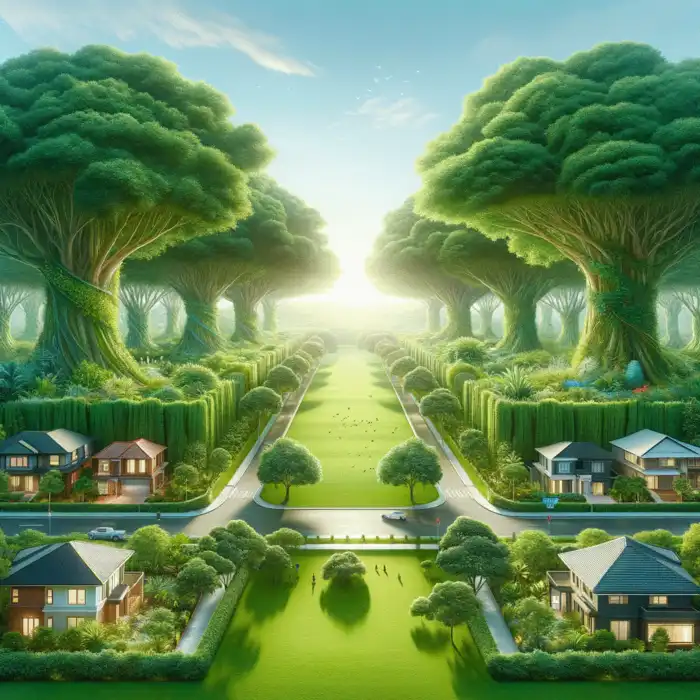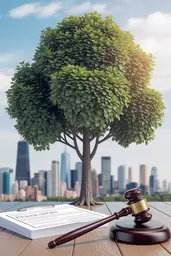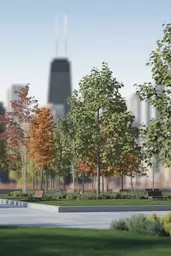Trees and Property Value Connection

Posted on: 2025-04-20
By: Keira Vallejo
What if I told you that trees can significantly boost the value of your home?
It's not just a theory; studies have shown that properties near green spaces command higher prices. As urban dwellers, understanding the economic value of trees can lead to smarter property decisions and enrich our communities.
What You Will Learn
- Urban forests are essential for enhancing property values by providing both aesthetic beauty and health benefits.
- Homes near well-maintained green spaces can see property price increases ranging from 5% to 15% compared to similar homes in less green areas.
- Hedonic valuation models help quantify the economic benefits of trees, illustrating the premium buyers are willing to pay for properties close to greenery.
- Factors like Leaf Area Index (LAI) and vegetation greenness play a crucial role in determining property desirability and value.
- Integrating green spaces into urban planning fosters community engagement and enhances overall well-being for residents.
Impact of Urban Forests on Property Prices
Exploring how urban forests influence property values through various key factors.
Price Increase Range
5% - 15%
Homes near well-maintained parks see significant price increases compared to less green areas.
Energy Cost Benefits
Lower Energy Costs
Properties with abundant tree cover enjoy reduced energy expenses due to natural shade.
Community Satisfaction
Increased Satisfaction
Access to green spaces enhances overall community satisfaction and leads to higher property values.
The Economic Value of Trees: How Green Spaces Boost Property Prices
Have you ever thought about how trees can impact the value of your home? It's fascinating to realize that the presence of urban forests can significantly enhance property prices! At Urban Canopy Blog, we believe that understanding this relationship is crucial for urban residents and community planners alike.
Trees not only beautify our cities but also provide substantial economic benefits. When we talk about the economic value of trees, we dive into how these green giants can influence property valuations. From improving aesthetics to providing shade, the benefits are numerous and worth exploring.
Understanding the Economic Value of Trees
The Role of Urban Forests in Property Valuation
Defining Urban Forests and Their Importance
Urban forests consist of trees and greenery found in cities, contributing to the overall health of urban environments. They play a vital role in improving air quality, reducing heat, and supporting biodiversity. These forests enhance our daily lives by creating spaces where we can relax, socialize, and enjoy nature—key factors that can make a property more desirable. Learn more about selecting the right trees for your urban space by reading our guide on selecting trees for urban spaces.
Moreover, urban forests serve as a natural shield against pollution, and they can even help to mitigate noise. This means that living near trees not only enhances your home’s value but also improves your quality of life! So, the next time you pass a park or admire a row of trees, remember that they are helping to elevate property values.
How Tree Cover Influences Residential Property Prices
The relationship between tree cover and property prices is well-documented. Research shows that properties surrounded by greenery tend to command higher prices. For example, studies indicate that homes located near well-maintained parks can see price increases ranging from 5% to 15% compared to similar homes in less green areas.
- Homes with abundant tree cover typically have lower energy costs.
- Neighborhoods with leafy streets often attract families and young professionals.
- Access to green space increases overall satisfaction, leading to a premium on property values.
In essence, the more trees present, the more valuable the surrounding properties become. It’s a win-win for homeowners and the community at large!
Quantifying Economic Value Through Hedonic Valuation Models
Introduction to Hedonic Valuation Models
Now, let’s delve into how we can measure the economic value of trees using hedonic valuation models. These models take into account various characteristics of a property and its surroundings to determine its market value. Essentially, they help us understand how much of a property’s value can be attributed to nearby green spaces. For more on the benefits of trees, check out our article on urban trees and mental well-being.
By analyzing data, these models can illustrate the premium that buyers are willing to pay for properties close to trees and parks. This kind of analysis is crucial for urban planners and policymakers who aim to integrate more greenery into city landscapes.
Factors Considered in Valuation: Leaf Area Index and Vegetation Greenness
Two key factors in these models are the Leaf Area Index (LAI) and the greenness of vegetation. The LAI measures the amount of leaf area in a given space, which directly relates to the overall health and density of a tree canopy. Greater leaf area often leads to increased property values!
- Leaf Area Index (LAI): Indicates the total leaf area relative to the ground area.
- Vegetation Greenness: Refers to the visual appeal and health of the surrounding greenery.
- Proximity to Trees: Closer distance to green spaces generally increases property desirability.
Understanding these factors aids in valuing properties more accurately and can guide efforts to enhance urban greenery effectively.
Did You Know?
A study conducted by the University of Washington found that homes located within 100 feet of a tree can see an increase in value by as much as 20%! This statistic underscores the incredible economic impact that even a few trees can have on property values. As urban environments evolve, integrating trees into our landscapes should be prioritized for both aesthetic and financial reasons.
Summarizing the Economic Value of Trees
As we wrap up our exploration of the economic value of trees, it’s clear that these green giants do more than just beautify our neighborhoods. They play a critical role in enhancing property values, contributing to both community pride and economic growth. In a city like ours, where every square inch matters, understanding how urban forests impact real estate is vital for residents, urban planners, and developers alike! For practical tips on keeping your urban trees healthy, see our guide on urban trees and cooling city heat.
When we look at the key takeaways about green spaces and property prices, it’s evident that the interconnectedness of urban forests and economic growth cannot be overstated. Trees not only provide aesthetic benefits but also promote healthier living environments that can significantly increase property values. By incorporating more green spaces, we contribute to the overall well-being of our urban landscapes.
Key Takeaways on Green Spaces and Property Prices
To emphasize the importance of integrating green spaces into urban planning, let's highlight some key points:
- Urban forests enhance property values by providing aesthetic and health benefits.
- Green spaces promote community engagement and foster a sense of belonging.
- The presence of trees is linked to lower crime rates and higher property appreciation.
Furthermore, the diverse case studies we've discussed show the varying impacts of trees on property values across different regions. Each community has unique needs and preferences, making it essential to understand local contexts when implementing green initiatives. This knowledge empowers us to create tailored solutions that resonate with our neighborhoods. For more information on seasonal tree care, you can check out our summer tree care tips for cities article.
Encouraging Sustainable Practices for Urban Development
In the spirit of fostering a greener future, it’s imperative for us to advocate for sustainable practices in urban development. It’s not just about planting trees; it’s about building a thriving ecosystem that benefits both people and the environment. Our mission at Urban Canopy Blog is to inspire action, and we believe that everyone has a role to play in this journey!
As urban planners and property developers, we encourage you to take part in community-focused green initiatives. Working together can lead to vibrant neighborhoods that prioritize health, beauty, and sustainability. We’re all stewards of our urban environments, and it’s time to embrace this responsibility wholeheartedly! Learn more about the benefits of professional tree care by visiting our article on benefits of professional tree care.
Call to Action for Stakeholders
Here’s how various stakeholders can contribute to promoting green initiatives:
- Urban planners can incorporate more green spaces in city designs.
- Property developers should consider eco-friendly building practices.
- Residents can participate in community tree planting events and workshops.
Engaging the community is key to the success of these initiatives! By encouraging residents to get involved, we create a sense of ownership and pride in our urban spaces. Together, we can ensure that greenery flourishes in our cities, resulting in happier, healthier communities.
Final Thoughts on the Future of Trees and Property Valuation
Looking ahead, the role of green spaces in building sustainable communities is paramount. As we continue to explore ways to enhance property valuations through urban forestry, we must commit to long-term strategies that prioritize both economic and environmental health.
Remember, investing in trees is not just about the immediate benefits; it's about securing a greener, healthier future for generations to come. The positive impacts of urban greenery will resonate throughout our cities, contributing to the well-being of both the environment and its residents. So let’s get out there and make a difference together!
Recap of Key Points
Here is a quick recap of the important points discussed in the article:
- Urban forests enhance property values by improving aesthetics, air quality, and providing shade.
- Properties near green spaces can see price increases of 5% to 15% compared to less green areas.
- Hedonic valuation models help quantify the economic value of trees, considering factors like Leaf Area Index and vegetation greenness.
- Trees contribute to lower energy costs, attract families, and promote higher community satisfaction.
- Engaging communities in green initiatives fosters a sense of ownership and helps ensure the sustainability of urban ecosystems.
Frequently Asked Questions
How much can trees increase my property value?
Studies show property values near green spaces can increase by 5% to 15%, or even more in some cases.
What methods are used to quantify the economic value of trees?
Hedonic valuation models are used, considering factors like Leaf Area Index (LAI) and vegetation greenness.
What are the benefits beyond property value increases?
Trees improve air quality, reduce energy costs, enhance community satisfaction, and contribute to a healthier environment.
How can I get involved in promoting green initiatives?
Participate in community tree planting events, support eco-friendly building practices, and advocate for more green spaces in urban planning.
 In urban environments, trees are often the unsung heroes contributing to our well-being and the over
In urban environments, trees are often the unsung heroes contributing to our well-being and the over
 Urban trees are essential to our cities, yet they face numerous threats from pests and diseases. Did
Urban trees are essential to our cities, yet they face numerous threats from pests and diseases. Did
 Did you know that urban tree diversity is crucial not just for aesthetics, but for the health of ent
Did you know that urban tree diversity is crucial not just for aesthetics, but for the health of ent